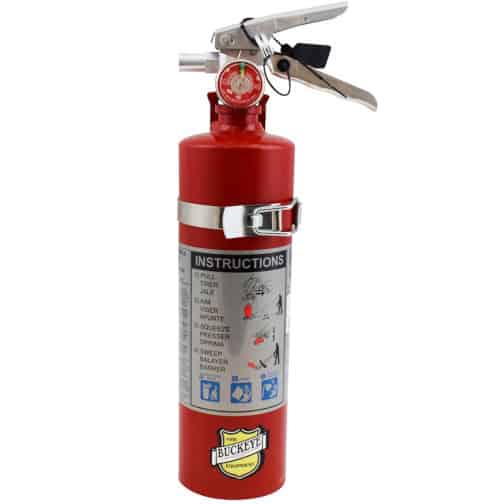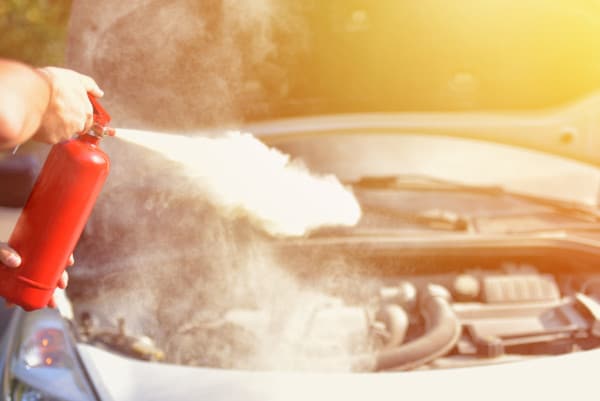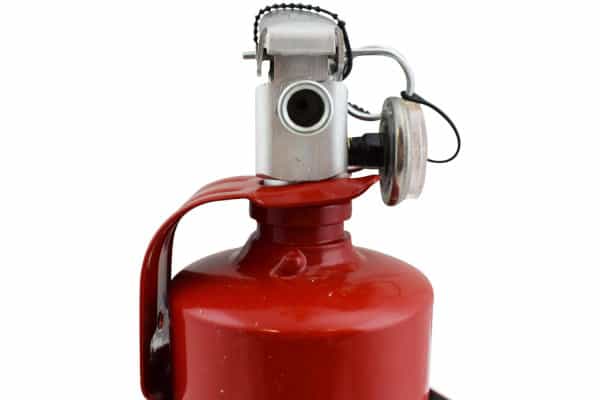Learn the rules, extinguisher types, and best practices for truck, RV, and car fire extinguishers
YouTube is filled with compilations of automobile fires at NASCAR races. But fires are not just a danger in motorsports; they are also a common peril for cars, trucks, and big rigs that travel the roads. A portable car fire extinguisher is a smart safety choice.
Motor vehicle fires are not uncommon due to the complexity of vehicles’ electrical and mechanical systems, not to mention the potential for oil or fuel to ignite. Some common causes of fires include automobile design flaws such as electrical issues, leaks in the fuel tank, and faulty batteries; electrical or mechanical failures with the car’s battery, issues with heated seats, the heating system, or aftermarket accessories; engine overheating; and leakage of motor oil, coolant, or transmission, power steering, or brake fluid.
The number of annual motor vehicle fires in the U.S. is much higher than you might think; the National Fire Protection Association (NFPA) estimated that there were 174,000 highway fires in 2015 alone. Given the risk, drivers should consider investing in a car fire extinguisher. While only certain vehicle classes are legally required to carry fire extinguishers, extinguishers give personal vehicle owners peace of mind—protecting your property and, in some cases, saving your life.
In this blog, QRFS examines the different kinds of fire extinguishers appropriate for automobile fires, what kinds of vehicles must have extinguishers, and some of the characteristics to look for when purchasing one.
Feel free to shop our selection of ABC dry chemical fire extinguishers that are ideal for most vehicles.
The type of car fire extinguisher needed depends on the specific fire hazard
Fire extinguishers are categorized according to the type of fires that they can handle. Fires are classified into five different types, with motor vehicles at particular risk for three of them:
- Class A fires: Comprising the lowest risk category, this class of fire is caused by combustible substances like wood, fabric, paper, and refuse.
- Class B fires are caused by flammable liquids like gasoline, grease, paint, etc. These are high-risk fires; if not contained immediately, they can quickly cause substantial vehicle damage and be fatal.
- Class C fires involve energized electrical components; “energized” meaning that they are fueled by a power source. Electrical fires are rated as Class E in many parts of the world, however, including Europe, Australia, and Asia.
Letters indicating the class are listed on each fire extinguisher along with preceding numbers, respectively serving to indicate that an extinguisher can douse a particular class of fire and how effective it is at doing so. The number before each class letter represents the extinguisher’s efficacy in terms of either an equivalent quantity of water or the square footage it covers.
A “2A:10B:C” fire extinguisher, for example, can be used on Class A, B, and C fires. Each digit before the A means that extinguisher’s agent delivers the equivalent of 1.25 gallons of water. Thus, a 2A fire extinguisher puts out the equivalent of 2.5 gallons of water (2 x 1.25) whereas 8A extinguishers are as powerful against ordinary combustibles as 10 gallons of water. The number before “B” represents square footage—a 10B extinguisher can put out 10 square feet of B fires. If an extinguisher has a letter “C” (as in 10B:C, 1A:10B:C, or 8A:C), the fire extinguishing agent doesn’t conduct electricity. That means that it’s suitable for use on fires involving energized electrical components (Class C fires).
Dry chemical and clean agent models work best for vehicle fires
Drivers should buy a car fire extinguisher that can handle the types of fires typical in motor vehicles. Dry chemical fire extinguishers, which work by interrupting the chemical reactions of the fire, are the most commonly used portable fire extinguishers that are effective against Class A, B, and C fires. Drivers should be aware that these types of fire extinguishers can cause damage to the engine and any electronic components under the hood—a small price to pay, however, when safety is on the line.
Another type that is popular among car owners is a clean agent fire extinguisher, which is also known as a halogenated extinguisher. These use a mix of gases to put out the fire and are effective against Class A and B fires. Some of the larger clean-agent extinguishers can also fight Class C fires, although a large model may not be suitable for a motor vehicle.
Motor vehicle drivers should avoid two types of common extinguishers: water and foam extinguishers and CO2 models. Water and foam fire extinguishers can only douse Class A fires; on a Class B fire, the foam can cause the fire to spread faster. And while CO2 fire extinguishers are effective on Class B and C fires, they do not stop Class A fires.
Fire extinguishers are mandatory for commercial trucks and buses and recommended in personal vehicles
Personal Cars
There is no legal requirement that personal motor vehicles carry a fire extinguisher but NFPA stipulates that recreational vehicles (RVs) should have a 5 pound BC extinguisher located near each exit. Owners of other personal vehicles often opt for a 2.5 lb. ABC dry chemical extinguisher that is light enough for easy handling and small enough to easily fit in most vehicles.
Commercial Trucks and Buses
All commercial trucks, truck tractors, and buses are required by federal law to have fire extinguishers—except those used in driveaway-towaway operations in which the vehicle is the commodity being transported and it has at least one set of wheels on the road.
A truck that is not transporting hazardous materials must be equipped with either a listed fire extinguisher with a rating of 5 B:C or more OR two listed fire extinguishers, each of which has a rating of 4 B:C or more.
Trucks that do transport hazardous materials requiring placarding (labeling) must carry a listed fire extinguisher with a rating of 10 B:C or more. “Listed” means that the technology has been tested by the safety organization UL. This video outlines the requirements for extinguisher types and mounting, plus shows some good examples of why these regulations exist:
Extinguishers should be mounted, easy to locate, and receive regular maintenance
In all types of vehicles, fire extinguishers should be readily available for use. The trunk of a car, for example, is an inconvenient place for one to be during a fire. In addition, drivers should securely mount the extinguisher(s) to prevent it from sliding or rolling around—in an accident, a flying fire extinguisher could be deadly.
Drivers should service or replace car fire extinguishers just like home or workplace models. Owners should recharge or replace them after every use, even if they weren’t completely discharged during their last operation. In addition, vehicle operators should ideally maintain any fire extinguisher via a monthly inspection and an annual service that may involve a refill.
What to look for in a vehicle fire extinguisher: lightweight, compact, and durable
When purchasing a fire extinguisher for a car or other vehicle, drivers should look for light weight and a compact shape; a small, elongated cylinder is practical and can easily be stored. Extinguishers should also be installed with a storage clip or vehicle bracket.
Another important characteristic is durability; fire extinguishers should have a rugged body that can withstand an accident. Aluminum-bodied cylinders are often preferred because they are light and corrosion resistant. In addition, drivers should ensure that the extinguisher has a strong trigger that allows for controlled discharge and ensures that the equipment delivers the foam effectively. Fire extinguishers must be labeled with safety certification, and a good warranty can indicate quality manufacturing.

Purchase quality vehicle fire extinguishers
Regardless of regulations, operators of all motor vehicles benefit from this protection during an emergency. Vehicle fire extinguishers must be durable, compact, reliable, and have the ability to put out specific fire types that are common on the road.
Buckeye, a North Carolina-based maker of fire extinguishers, offers extinguishers that are perfect for cars and other vehicles. Their portable dry chemical fire extinguishers are rated for Class A, B, and C fires. They range in size from 2 1/2 pounds (1A:10B:C) to 20 pounds (10A:120B:C). Each extinguisher is compliant with standards established by the NFPA, the Department of Transportation, and the US Coast Guard. Matching fire extinguisher mounting brackets are also available.
Shop our selection of ABC dry chemical fire extinguishers.
If you have any questions about buying, placing, or replacing a car fire extinguisher, call us at 888.361.6662 or email support@qrfs.com.
This blog was originally posted at blog.qrfs.com. Check us out at Facebook.com/QuickResponseFireSupply or on Twitter @QuickResponseFS.




I owned a class C and I am finding a good fire extinguisher for my RV but I don’t know what is the best in today’s market. Are you willing to recommend some types for me?
Iris, we will have someone from our QRFS customer support team reach out to assist!
What is the best location of installed Fire Extinghisher in Vehicle as per Standard, Please support.
Thanks for reaching out. In all types of vehicles, fire extinguishers should be located where it is readily accessible for use. The best location will depend on your vehicle. The trunk of a car, for example, is not a good location to install a vehicle fire extinguisher because you will not be able to easily access it during a fire. In addition to placing the fire extinguisher in an accessible location, drivers should securely mount the extinguisher(s) to prevent it from sliding or rolling around—in an accident. Hope this helps!
I have an F 150 pickup truck with a commercial tag. Am I required to have a fire extinguisher?
To our knowledge, all commercial *trucks,* truck tractors, and buses are required by federal law to have fire extinguishers—except those used in driveaway-towaway operations in which the vehicle is the commodity being transported and it has at least one set of wheels on the road.
A truck that is *not* transporting hazardous materials must be equipped with either a listed fire extinguisher with a rating of 5 B:C or more OR two listed fire extinguishers, each of which has a rating of 4 B:C or more.
This QRFS model fulfills the requirement and includes a vehicle bracket: https://blog.qrfs.com2-5-lb-buckeye-abc-dry-chemical-extinguisher-1a-10b-c
Can a car fire extinguisher legally be installed on the exterior of a vehicle? In some countries, lots of utility vehicles have an extinguisher securely mounted on the sports bar behind the cab. Saves space inside and great access regardless of where the fire is (engine bay, inside or the load tray). I want to move a fire extinguisher from inside the rear door of my slide on camper to the front wall of the camper body (which is therefore just behind the cab)?? Can I do this? Thanks
Phillip, rules governing this are not explicit in fire code but typical automotive extinguishers are intended for use inside vehicles. There may be serious implications when it comes to collisions and the potential for the extinguisher to become a projectile. We’d suggest contacting the National Highway Safety Administration: https://nationalhighwaysafetyadministration.com/en/
Appreciate that with all the work you’ve placed into it
Hi, what is the best fire extinguisher to get for use on a lithium ion powered golf cart?
Laurel – Lithium-ion battery fires are class B fires, so an ABC dry chemical or CO2 extinguisher should do the trick.
Hi, what’s the best fire extinguisher to use in a shop that will be storing appx 5 to 20 cars and doing small repairs on cars? it was mentioned I need a “brt” extinguisher, but I think they may have confused the acronym.
Alyssa — At a basic level, ABC extinguishers are appropriate. But the exact types, number and size of extinguishers, and their placement vary based on exactly what is being stored in the facility and how big it is. This QRFS guide goes over key considerations.
If you would like a custom analysis for your facility, you can submit a question through QRFS Ask A Fire Pro. Click the link to submit your question with some information about your building, and a fire protection professional will provide a detailed answer based on standards and codes. Our pros include AHJs, contractors, engineers, and code experts with 150+ years of combined experience!
In regarding commercial vehicles that require the “fire extinguisher inside” sticker/s what are the DOT/MTO requirements on location, reflecting or not? color and size
Tha j you
Robert — We are not aware of the exact rules extemporaneously, though some trucking forums seem to imply there aren’t explicit, detailed extinguisher signage requirements. (We would not fully trust comments on an internet forum.) If you’d like, we can have our professionals research the answer via our Ask a Fire Pro service, however. Click the link to submit your question with some information about your vehicle and its purpose, and a fire protection professional will provide a detailed answer based on standards and codes. Our pros include AHJs, contractors, engineers, and code experts with 150+ years of combined experience!
Otherwise, the DoT website has the full list of regs: https://www.fmcsa.dot.gov/
Thanks for the tips you have provided through your blog. Nice blog!
Nice Blog! Thanks for the information you have provided through your blog.
Thanks for sharing useful and wonderful information. Keep sharing more content.